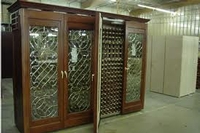When it comes to long-term wine storage, the three most important things to consider are light, humidity, and temperature.
Let’s start with light. The reason to be concerned if too much light strikes the bottles being laid down for future enjoyment is that UV rays can ultimately damage wine, especially lacy, delicate wines. This is why premium wine is almost always packaged in light-inhibiting tinted bottles (and why Cristal Champagne comes with a protective anti-UV wrapper around its clear glass bottle). Wine is traditionally stored in the dark, but in truth there isn’t much evidence to prove that low, non-UV light causes damage.
As for humidity, it’s long been suggested that excessively dry air can cause corks to dry out and shrink away from the sides of the bottle, leading to oxidation and other spoilage from air seeping into the wine. Of course the corks are protected to some extent by the foil capsule, but since I’ve had personal experience with crumbling corks in dry desert climates, I’m inclined to believe in the value of humidity control (incidentally, one reason wine experts typically advise against storing wine long-term in the fridge is because of concern that a refrigerator’s dehumidifying cycles might eventually damage the corks).
 One thing everyone seems to agree on is that the most crucial factor concerning wine storage is temperature. Wine is remarkably affected by the ambient temperature: High temperatures accelerate aging, low temperatures slow down the maturing process, while long stretches of exposure to extreme temperatures can apparently produce undesirable chemical changes in the wine.
One thing everyone seems to agree on is that the most crucial factor concerning wine storage is temperature. Wine is remarkably affected by the ambient temperature: High temperatures accelerate aging, low temperatures slow down the maturing process, while long stretches of exposure to extreme temperatures can apparently produce undesirable chemical changes in the wine.
Most experts suggest 55-60F (11-13C) as the ideal temperature for wine storage. (Tom Stevens, in The Sotheby’s Wine Encyclopedia, believes 52F, or 11C, is just about right). There’s no doubt that chilly works best, but almost more important than the actual temperature is that it be constant, for temperature fluctuations are known to play havoc with wine that is meant to be slumbering for the long haul.
So where should you lay your wine down to ensure graceful aging? The wine storage unit business, an impressive growth industry, offers innumerable options to consumers who want to store anything from a single bottle up to several hundred cases in temperature-controlled environments. Some wine collectors rent an off-premise commercial storage facility designed for the purpose, others use a simple, dark closet or other comparment dedicated to holding wine. If you happen to have access to an underground cave that’ll work, for cave temperatures are notoriously hospitable to wines.
But here’s another idea: how about storing your wines at the bottom of the sea? Recent hauls from shipwrecks seem to indicate that the ocean floor may just be the most ideal place to store wine, especially Champagne. The most stunning example of this theory put to practice was the discovery last year of at least 30 bottles of Champagne lying in the wreckage of a sailing vessel 180 feet (55 meters) under the Baltic Sea.
Christian Ekstrom, who led the team of seven Swedish divers that recovered the cargo, reported that since the underwater visibility was so poor he brought one of the bottles up to the surface to help establish the date of the wreck. Of course the divers popped the cork to have a taste, and discovered to their amazement that it was a sparkling wine. According to Ekstrom, it still had fizz, and it tasted sweet and “fantastic.”
The considerable detective work that followed established that the wine was almost certainly Veuve Clicquot, and was made sometime between 1782 and 1788. According to one wine expert who tasted it, the wine had plenty of bubbles, was a dark golden color, and had an intense aroma, some fruit and some acidity, as well as the considerable sweetness typical of Champagne from that era.
It is certainly the oldest drinkable Champagne known. There is impressive evidence that it was part of a consignment sent by King Louis XVI to the Russian Imperial Court. Current speculation is that the opening price at auction for each bottle may be around $69,000.
Not all undersea wine storage is accidental. Vina Casanueva, a Chilean winery, produces a line of wines that are stored intentionally on the seabed. Patricio Casanueva, the winery’s general manager, maintains that the combination of pressure and constant temperature make ideal wine storage conditions for his estate’s Cabernet and Muscat-Chardonnay wines. The perfect wine to serve with fish, perhaps?
7
